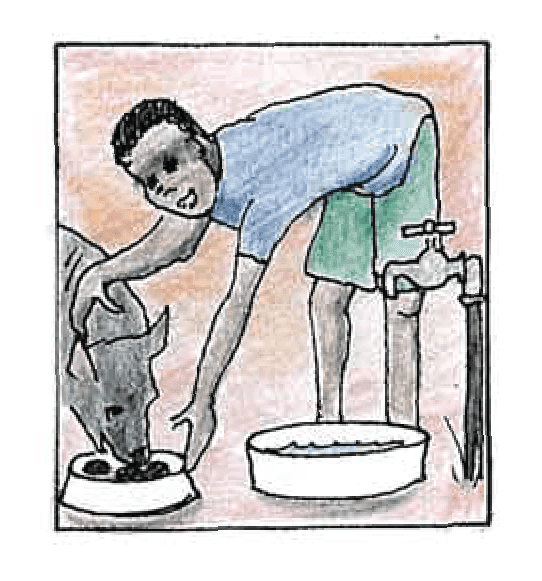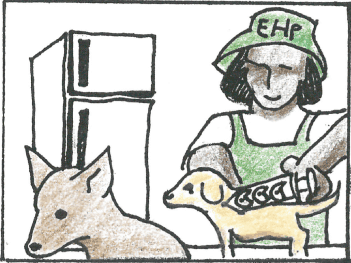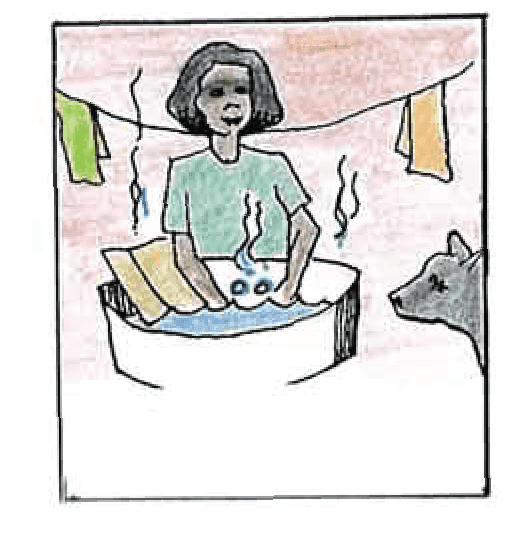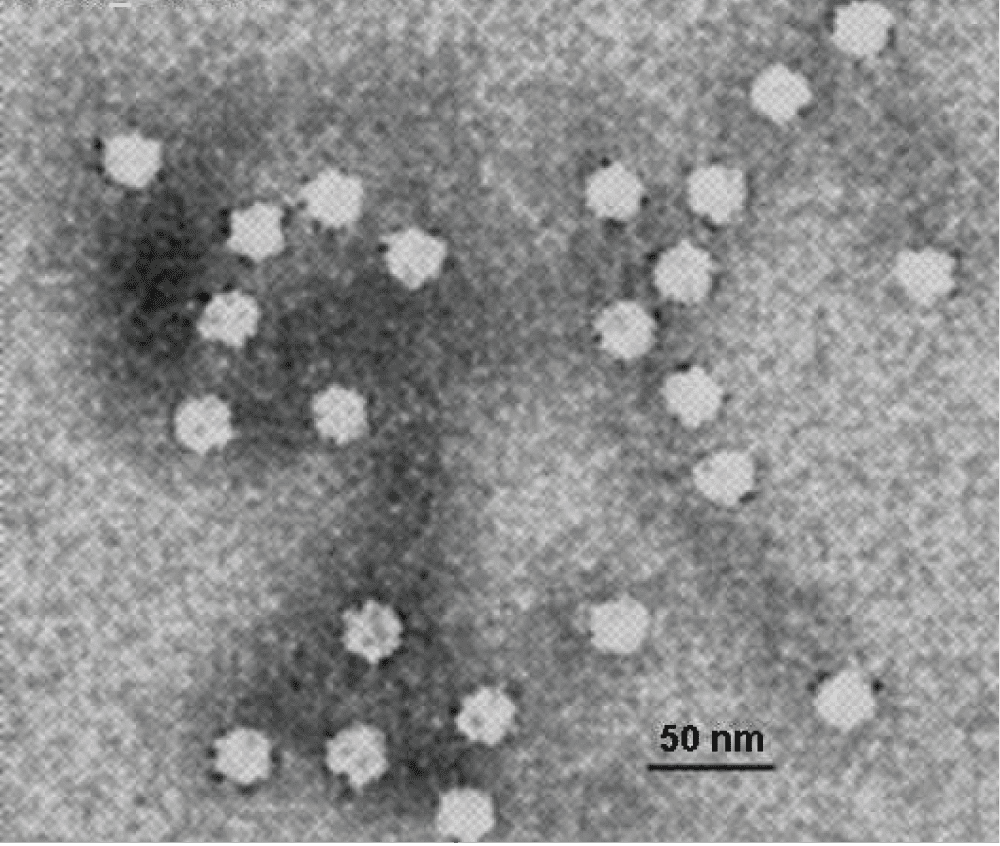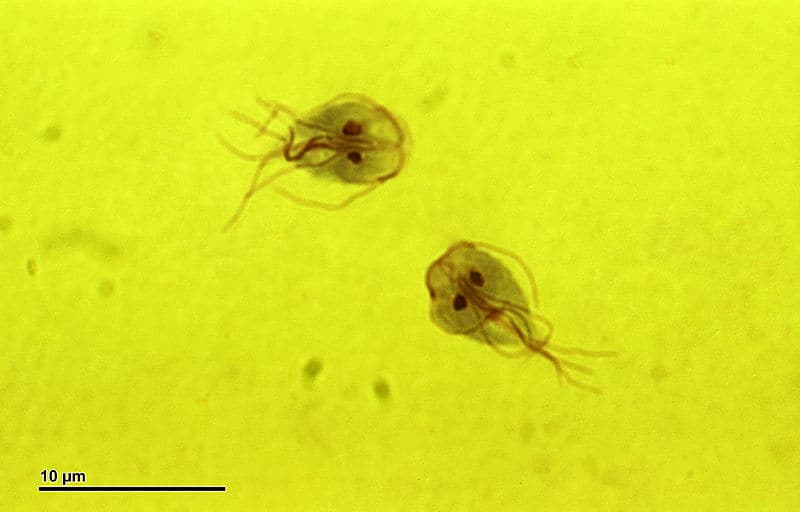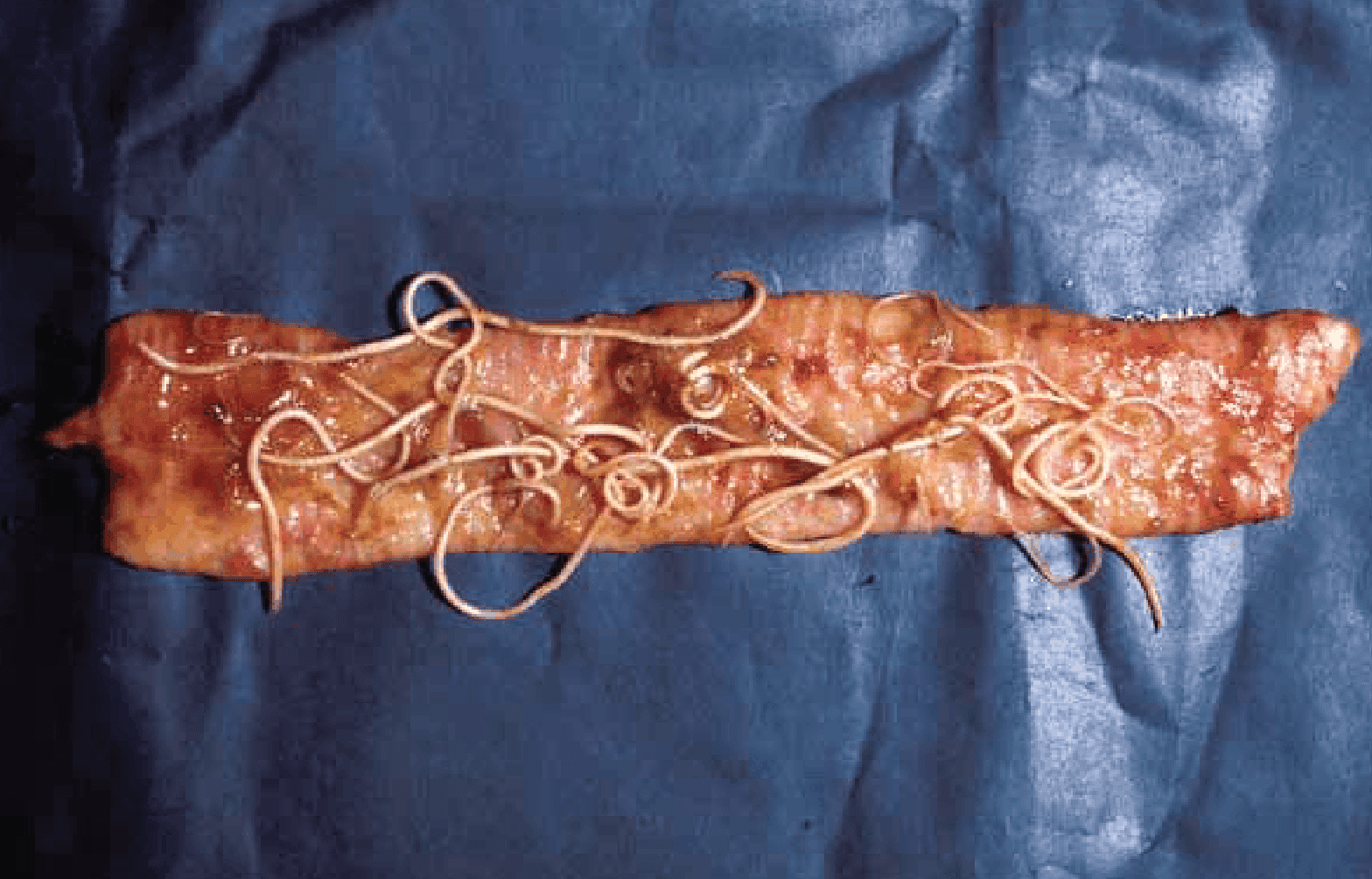CHAPTER THREE
Germs and immune systems
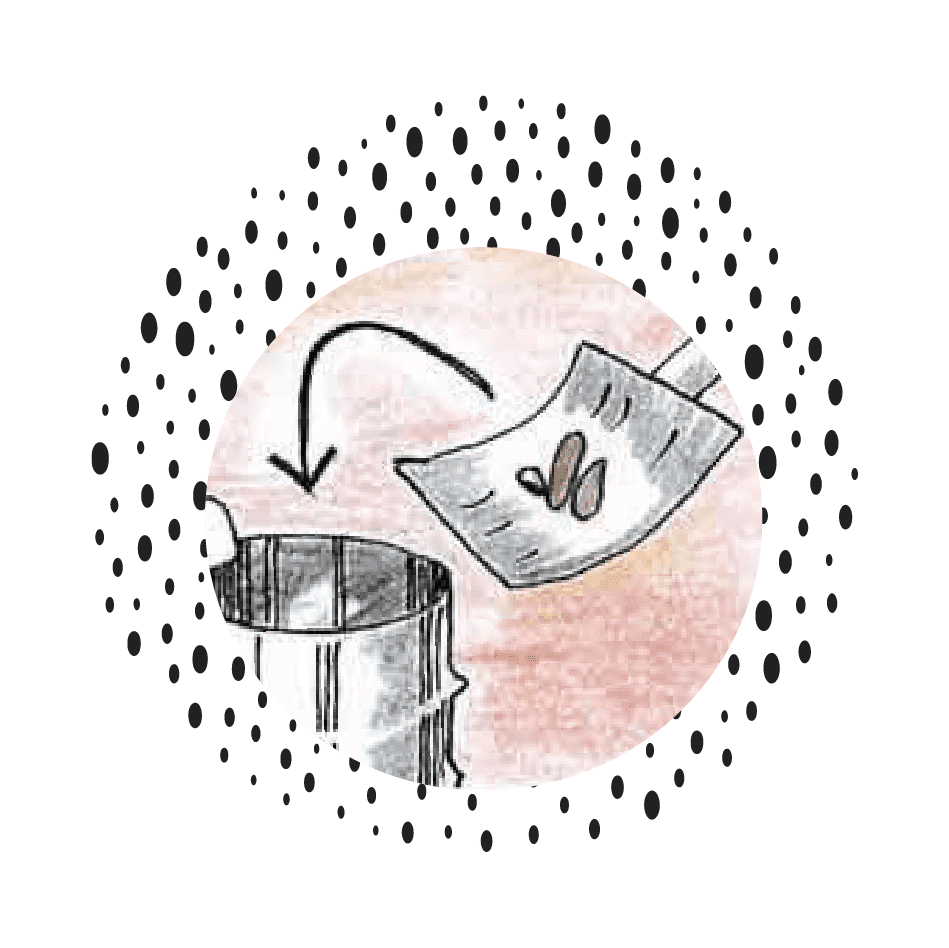
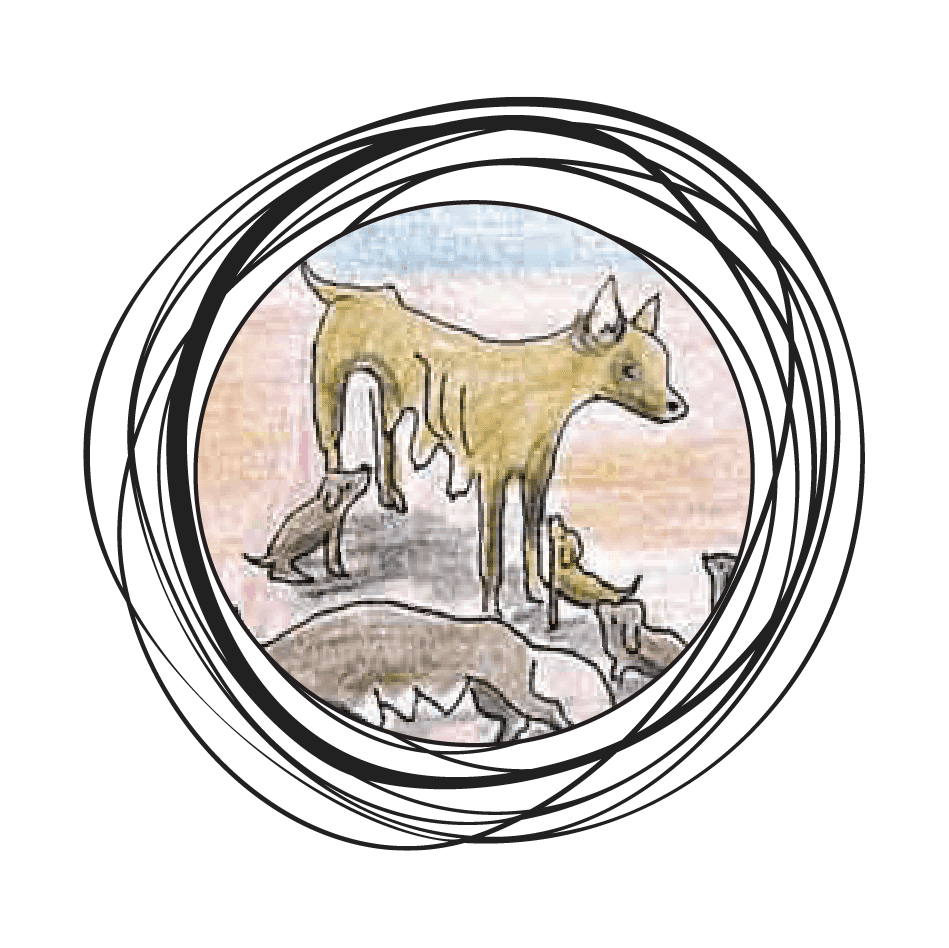
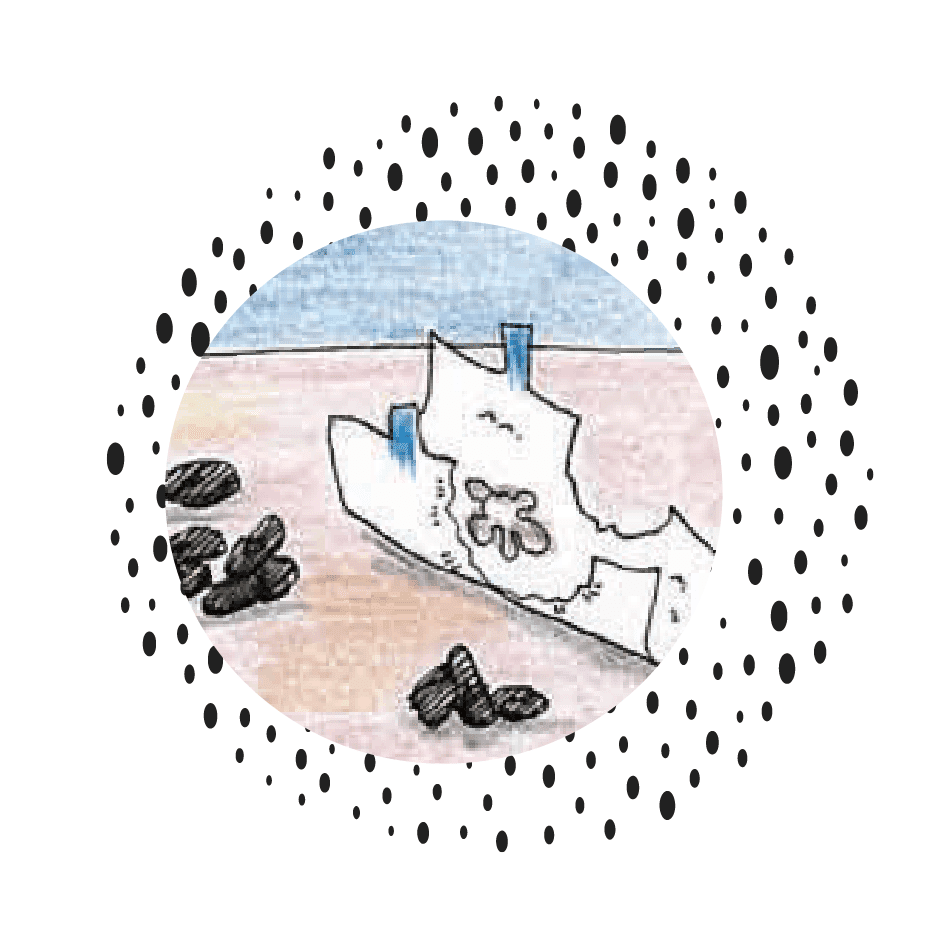
Animals and people get sick from all sorts of things.
Sometimes they get sick from germs.
Germs are like small animals.
Germs can breed up inside a sick person or animal.
Most germs are too small to see. They can only be seen with a microscope.
They can move from animal to animal or person to person.
Some germs can move from animals to people.
There are four main types of germs that we talk about.
These are viruses, bacteria, protozoa and parasites.
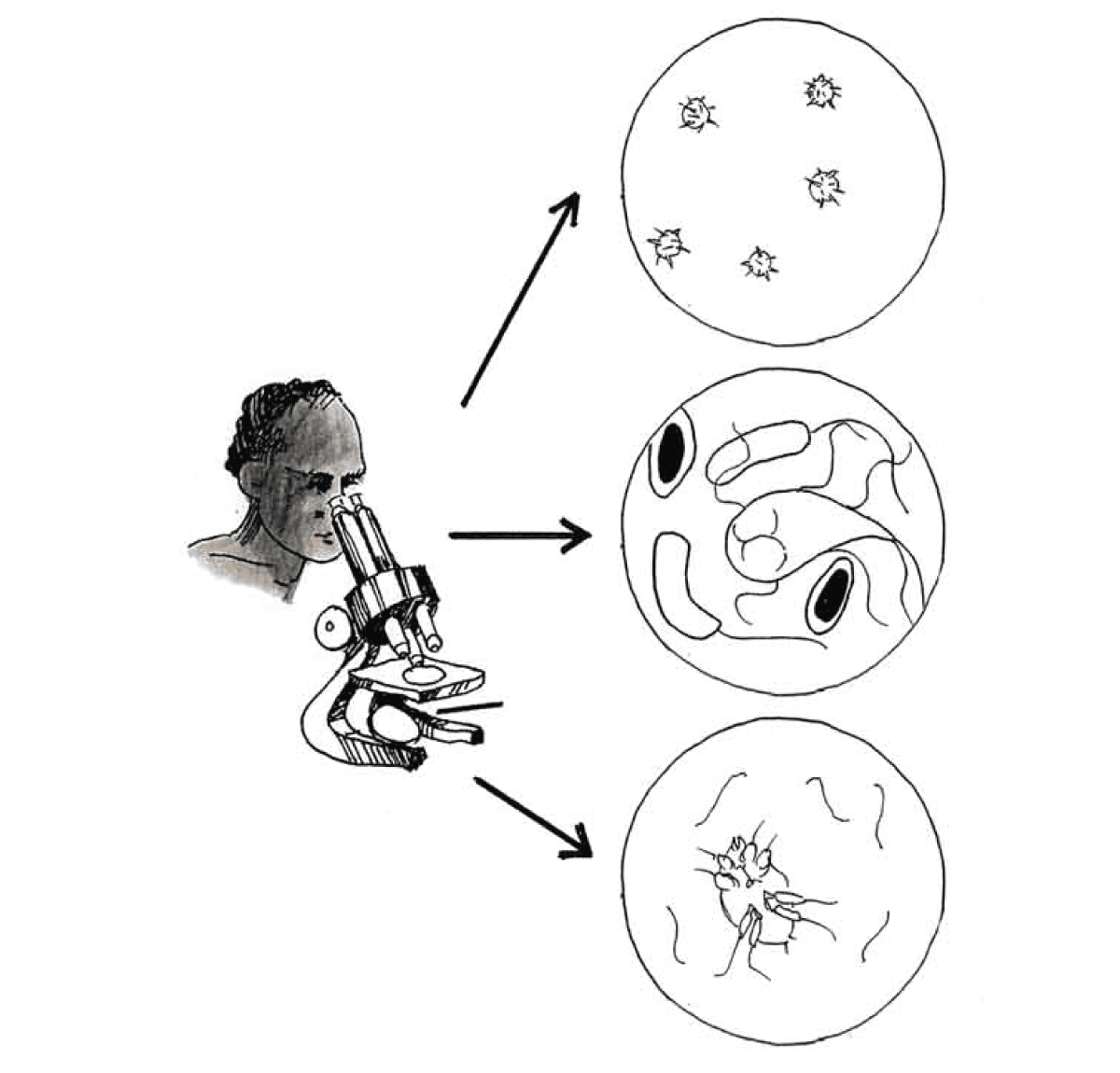
Did you know?
Germs that move between animals and people are called zoonoses.
A big part of the animal health and management program is working to prevent zoonoses.
Viruses
Viruses are the smallest types of germs.
The rotavirus and the flu are types of viruses that make people sick.
Parvo virus is a virus that makes dogs sick.
Bacteria
Bacteria are bigger than viruses.
You still need a microscope to see them.
Not all bacteria are bad. Some bacteria keep our skin and gut healthy.
But some bacteria can make us very sick.
Protozoa
Protozoa are a little bit bigger than bacteria, but are still too small to see without a microscope.
Giardia and Toxoplasma are types of protozoa.
Giardia can be spread by faeces from infected people or animals, and can contaminate water or food.
Toxoplasma can be carried by cats, and can contaminate food.
People and animals can get sick from Giardia and Toxoplasma.
Parasites
A parasite is a germ that lives in or on another animal or person.
Some common parasites in dogs and cats are:
- Gut worms
- Scabies mites
- Fleas and Ticks
Some parasites can only be seen with a microscope. Others are bigger so you do not need a microscope to see them.
Dog roundworm for example, can be seen in the faeces of dogs and people that are infected.
Germs breed up in sick animals.
If people are not careful to clean up after the sick animal, the environment where the animal lives can get lots of germs in it.
All these germs that are in the environment are called the reservoir of infection.
This reservoir of infection means the germs that are hiding and living in the environment.
If there is a large reservoir of infection there are more germs in the environment.
If we want to stop disease spreading we need to make the reservoir of infection smaller.
We need to make the number of germs in the environment less.
Clean dirt and dirty dirt
The dirt around houses where lots of people and animals live will have more germs in it than dirt in the bush.
Germs can come from sick animals or people
-
- If there are sick dogs or cats in a yard some of their germs will move into the dirt. Sick pets may leave things likes scabies mites or worm eggs in the dirt.
- Sick people can also leave germs in the yard. Sick people’s spit and snot can have lots of germs in it.
Germs can come from faeces (poo)
-
- Faeces puts worm eggs and germs that cause diarrhoea into the dirt. The faeces may be from dogs, children or leaking septics.
Germs can come from food and rubbish rotting on the ground
-
- Bacteria like Salmonella will breed up quickly in rotting food and rubbish.
- Flies can then move these bacteria onto people’s food
- If dogs eat this rubbish their faeces may also have Salmonella in it.
Germs can come from dead animals
-
- Dead animals or carcasses left to rot on the ground are full of bacteria that can make people and animals sick.
How long do germs stay alive in the dirt?
How long germs live for in the environment depends on:
What germ it is
-
- Some germs can live outside a person or dog’s body for a long time.
- Other germs die quickly when they are outside a person or animal’s body.
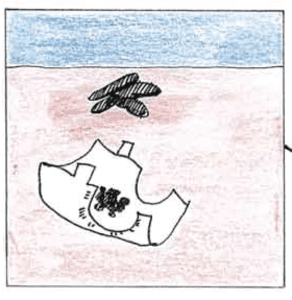
Did you know?
Dog Parvovirus can live for months in the dirt. It can also be moved from place to place by people’s shoes or vehicles.
It is a very tough germ.
What the environment is like
Germs can live for longer if the dirt is:
-
- Damp; water in the dirt lets most germs live longer
- Cool; germs can survive longer when they are not too hot
- Shaded; sun kills many germs. Scabies mites die quickly when the heat of the sun is on them.
Rubbish in yards or cracks in concrete also give germs a hiding place and help them to live longer.
If the germs live a long time the reservoir of infection can get bigger and bigger.
This is important with things like dog worm eggs.
Dog roundworm eggs can live for months if it is not too hot.
If a female dog is having lots of pups, the dirt in that yard can get dangerous numbers of dog roundworm eggs in it.
Dog roundworm can make dogs and people sick.
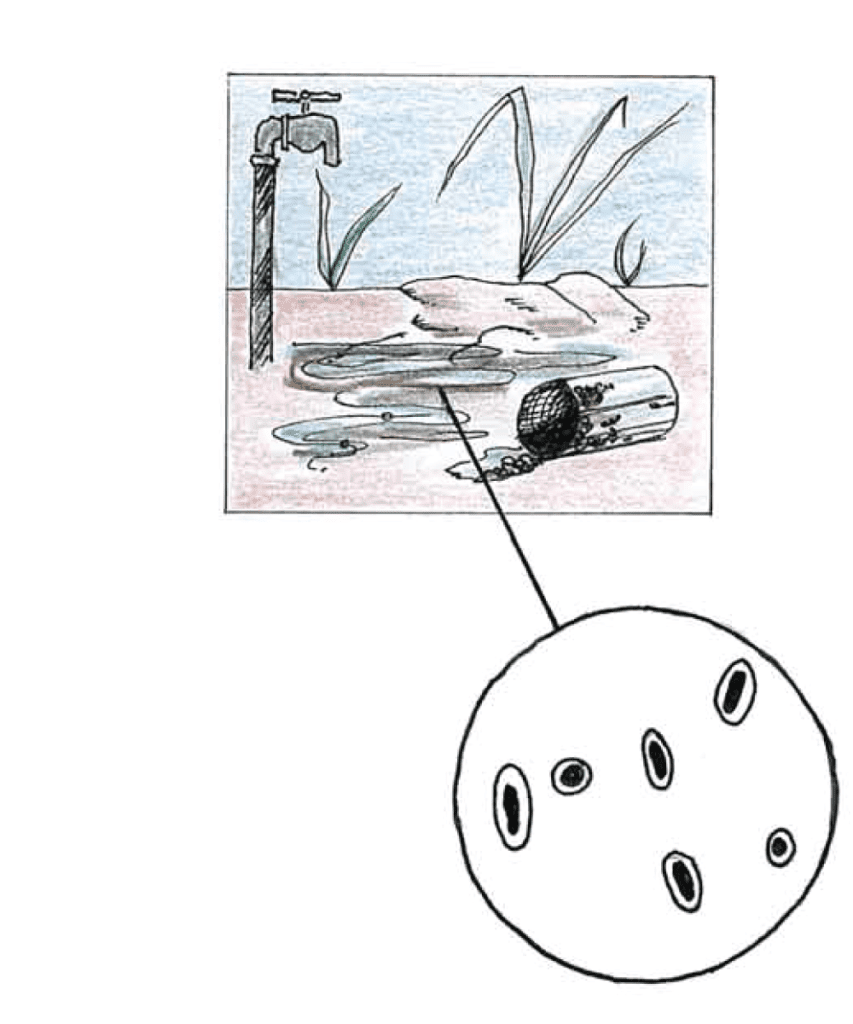
How do germs get inside people and animals?
Different germs have different ways of moving from one person or animal to another.
There a lots of ways germs can spread.
1. By touching.
You cannot see them but the germs can sit on people’s skin and animal’s fur. Germs are also in snot and spit, urine and faeces.
When people or animals touch each other the germs can be passed from one person or animal to the next.
The bacteria that cause school sores can be passed on this way.
Germs are also in beds and blankets where sick people and animals lie. The germs can move onto people or animals when they lie on these things.
Scabies moves around this way.
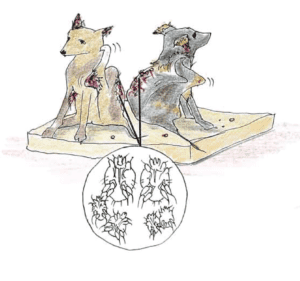
2. By being swallowed.
Germs can be swallowed by:
Eating with dirty hands.
People carry lots of germs on their hands. If they put their hands in their mouths the germs go into their mouths too.
Germs like diarrhoea germs or dog worm eggs can be on people’s hands without them knowing.
Washing hands with soap and water will wash these germs away.
Washing hands before eating is very important.
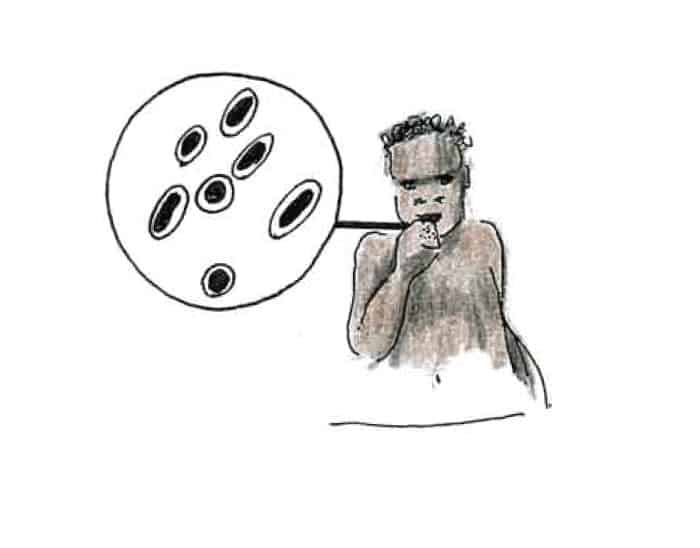
Drinking dirty water.
Some germs can live in water. If animals or people drink this water they can get sick.
Giardia is a type of protozoa found in water. Giardia gets into the water when human or animals faeces gets into the water source.
Letting dogs lick children’s mouths.
If dogs lick children’s mouths they will also be putting germs straight into the child’s mouth.
If the dog eats good food and is wormed the germs might not make people sick. But if the dog has been eating nappies or is wormy the germs on their tongues can make children sick.
Eating food that has germs on it.
Germs can get on food by:
-
-
- Flies or cockroaches walking on it.
If flies and cockroaches walk on rubbish, rotting things or faeces they get germs on their feet. When they land on food or people they will spread the germs. Salmonella can be spread this way.
-
- By sharing food bowls with animals.
Dogs can have bacteria and worm eggs on their tongues. If dogs share from people’s bowls these bacteria and worm eggs can get on people’s food. If dogs have shared food bowls, clean the bowls with hot soapy water.
-
-
-
- Leaving food out of the fridge.
If food sits out in the warm air, bacteria that are on the food can breed up.
-
-
When there are lots of bacteria on the food the food can make people and animals sick.
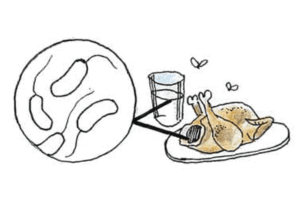
3. By being breathed in.
Some germs can float around in the air. They get into people when they breathe the air in.
If someone has a cold the coughing and sneezing pushes germs from the sick person out into the air.
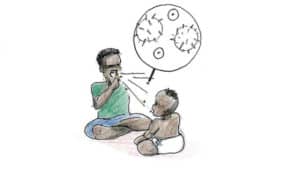
4. By getting in through the skin.
Some germs can move through people’s skin.
If people or animals sit in dirt that has germs in it, the germs can move through their skin. Clothes and shoes will stop the germs moving in.
Dog roundworm, Strongyloides stercoralis, and Leptospirosis can get into people through their skin.
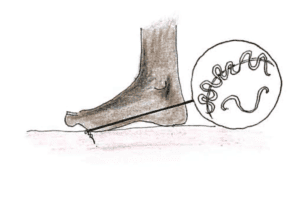
5. By being bitten by insects.
Some germs breed in fleas, ticks and mosquitoes.
When the flea, tick or mosquito bites a person or animal they can put the germs under the person or animal’s skin.
Dog heartworm can be spread this way.
Some other sicknesses like the germs that cause Q Fever or Tick Typhus can be spread this way too.
When fleas, ticks and mosquitoes bite people, they also cause a break in the skin. This break in the skin can then become infected by bacteria like Streptococci.
When people get lots of skin infections, they are more at risk of developing serious heart problems and kidney disease.
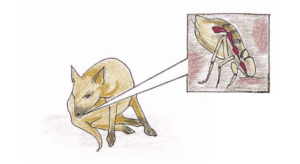
When will a germ make a person or animal sick?
Germs do not always make people or animals sick.
For a germ to make a person or animal sick there needs to be:
1. Enough of the germ taken into the animal or person.
The number of germs needed to make a person sick is called the “infective dose”.
For scabies in dogs the infective dose is small. It only takes one or two scabies mites to make a dog very itchy.
For Salmonella in dogs the infective dose is quite high. A dog needs to eat about one million Salmonella bacteria before it will get diarrhoea.
2. A weak immune system that can’t kill the germ.
If the immune system is not strong, the germs can breed up and the body will not be able to fight off the infection.
Strong and weak immune systems
If a person or animal is healthy their immune system will be strong.
A strong immune system can fight off germs and stop them breeding up inside a person or animal.
A weak immune system can’t fight off the germs. The germs can then breed up. This means the person or animal gets sick from the germ.
Some animals and people have weaker immune systems.
Animals
- Puppies and kittens, very skinny animals and very old animals will have weaker immune systems.
- Pregnant animals also have weaker immune systems.
- Animals that are already sick will also have a weaker immune system.
People
- Children, pregnant women and old people will have weaker immune systems.
- People who have other sicknesses also will have weaker immune systems. For example, people with diabetes, kidney failure or people on steroid medicine will have weaker immune systems.
- Stress and worry can also weaken a person’s immune system.
If there are too many types of germs in the environment the immune system is always working hard, trying to protect the body.
This might stop the person or animal looking sick on the outside but on the inside their immune system can get weak.
Keeping animal’s immune systems strong
Keeping dogs’ and cats’ immune systems strong is one way that you and the community can stop germs building up in the environment.
Because dogs and cats can carry germs that can spread to people, this is a very important job both for animal health but also community health.
For houses that have people who might have a weakened immune system, keeping their animals healthy is especially important.
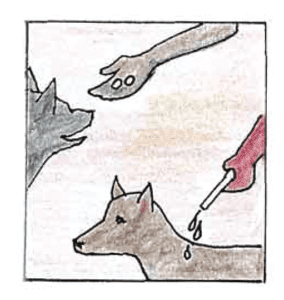
EHPs and animal owners can make dogs and cats immune systems stronger by:
Making sure animals are:
-
- Well-fed with good food (rotting food is bad for animals)
- Regularly given anti-parasite medicine
- Stopped from breeding too much
- Given a bath every now and then
- Vaccinated for common diseases like Parvovirus
- Kept isolated if they are sick, so that they don’t spread the germs to other animals
Keeping the environment clean:
-
- Use a bag to pick up any faeces or used nappies, and putting it all in the rubbish bin (and washing hands with soap and water afterwards!)
- Use good hygiene – wash good dishes and cups in hot soapy water and keep the house and bathroom clean
- Wash animal beds (old wet foam beds can be full of germs)
- Don’t keep too many dogs or cats
- Fix leaks and stop water from lying in the yard
- Use bins to stop animals eating rubbish (including rotting meat, bones or food)
Vaccinations and the immune system
A vaccination is a way of introducing the body to a germ in a way that will not make the body very sick.
Vaccinations are made from dead or weak germs, and are usually given by a needle.
The immune system can fight these dead or weak germs easily.
After a vaccination is given to an animal or person, their immune system makes antibodies and white blood cells which remember the germ and the best way to attack it.
These antibodies and white blood cells are then ready and prepared to fight the real germ if it ever gets into the person or animal.
By helping the body to fight germs, vaccinations help to keep animals and people healthy.
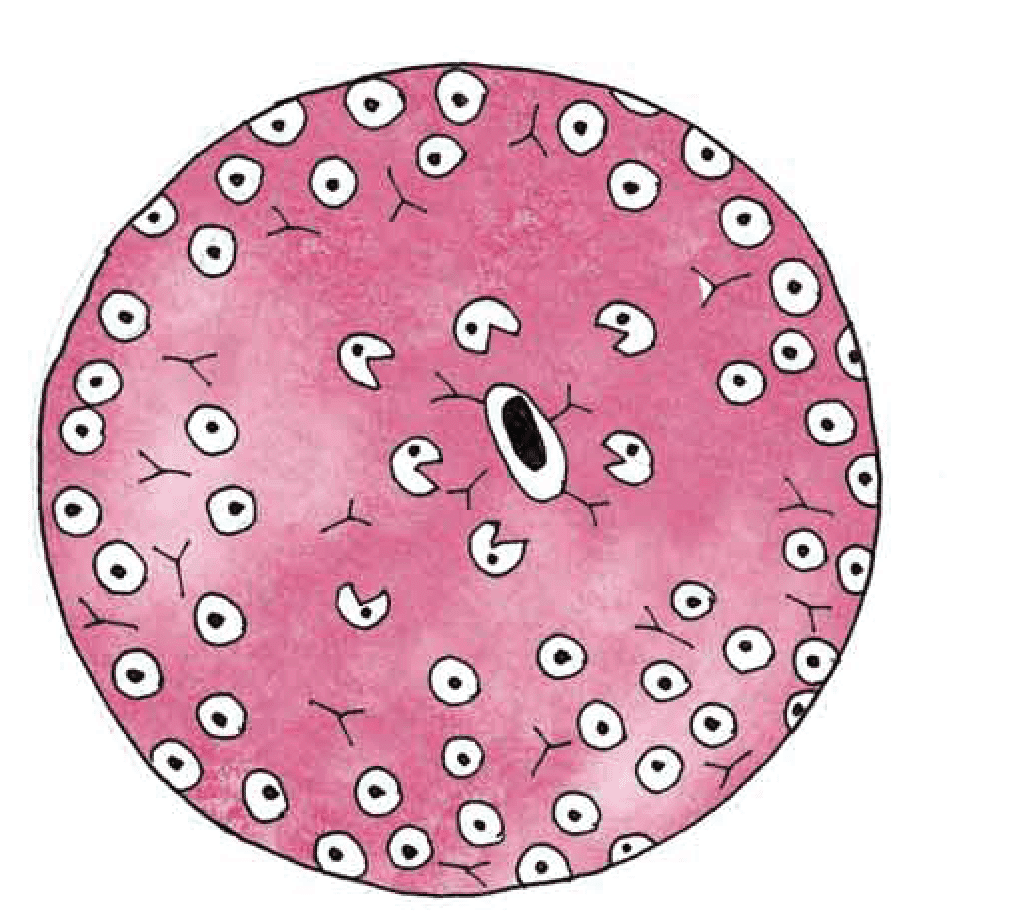
As an EHP, you can work with your vet on starting a vaccination program.
For dogs, the most common viral diseases that we vaccinate against are canine distemper, hepatitis and Parvovirus.
Cats can be vaccinated against feline panleukapaenia (FPV), feline herpes virus (FHV-1) and feline corona virus (FCV).
There are also other dog and cat diseases that can be vaccinated against if needed.
Talk to the vet about which vaccinations would be best suited for your community, and when the animals should have the vaccinations.
